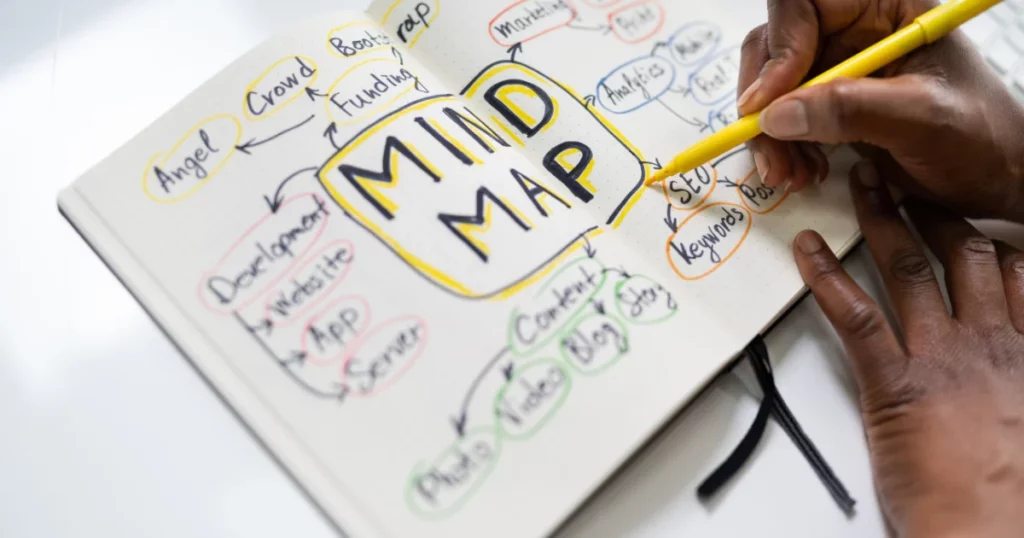Table of Contents
ToggleThe Underestimated Power of Note-Taking
Taking notes while learning has several unbeatable advantages that we often overlook. Let’s quickly iterate why note-taking should be your go-to strategy:- Memory Reinforcement: Note-taking assists in embedding new phrases, idioms, and complex grammar rules deep into your memory, creating a lasting imprint.
- Personal Learning Repository: Your notes serve as a personalized learning repository, allowing for quick revisions anytime, anywhere.
- Pattern Recognition: As your notes accumulate, they will start reflecting patterns in the English language, which can be a powerful tool in speeding up your learning curve.
Strategies to Ace Note-Taking
Building a powerful note repository is no small feat. Here are some strategies that can steer you in the right direction:- Mind Mapping: This visual note-taking strategy can be incredibly effective. Using mind maps to organize words and ideas around a central topic not only makes your notes organized but also visually appealing.
- Two-Column Notes: This is a straightforward yet efficient method where you bifurcate your page into two columns. Use one for main points or keywords and the other for detailed explanations, helping you quickly grasp the crux of the learning material.
- Abbreviations and Symbols: Craft a system of abbreviations and symbols that resonate with you. This method helps in speeding up the note-taking process without losing the essence of the information.
- Interactive Note-Taking: Engage with your notes actively by adding questions, comments, or even doodles. This approach makes your note-taking process interactive and enjoyable.
- Audio and Video Notes: In the digital era, don’t restrict yourself to textual notes. Try creating audio or video notes that you can revisit later. It not only saves time but also aids in better retention through auditory and visual cues.
Digital Tools to Upgrade Your Note-Taking Game
Stepping into the digital world, we have a plethora of tools at our disposal to make note-taking a breezy experience. Here are some tools you can leverage:- Evernote: A versatile tool that allows for a variety of note-taking formats including text, audio, and more.
- OneNote: Microsoft’s note-taking platform offers seamless integration with other MS Office apps, offering a comprehensive note-taking experience.
- Google Keep: Known for its simplicity and ease of use, it’s a great tool for quick note-taking, setting reminders, and more.
Conclusion
As we wrap up, remember that mastering note-taking is a gradual process. Start with simple strategies and gradually evolve your style as you become more comfortable. With dedication and the right techniques, your note-taking can become a powerful ally in your English learning journey, helping you build a robust understanding and eventually facilitating a smoother transition into English-speaking environments, be it in the United States or anywhere else globally. Keep coming back for more insights and tips to navigate your English language learning path. Remember, every note you take is a step towards mastery. Happy learning, and until next time, keep noting!Exercises
- Objective: To develop a mind map that visually organizes new vocabulary around a central theme.
- Instructions: Choose a theme (e.g., family, food, emotions) and create a mind map adding new words and phrases related to the central theme.
- Objective: To familiarize learners with the two-column note-taking strategy.
- Instructions: While listening to a podcast or watching a video, take notes using the two-column method. Share your notes with a peer and discuss.
- Objective: To create personal abbreviations and symbols for quick note-taking.
- Instructions: List 20 common phrases or words you come across while learning English and create your abbreviations for them.
- Objective: To make the note-taking process interactive.
- Instructions: As you read an English article, take notes interactively by adding questions, comments, and illustrations to your notes.
- Objective: To familiarize learners with digital tools for note-taking.
- Instructions: Choose a digital tool mentioned in the blog and create a set of notes on a topic of your choice.
- Objective: To create audio notes summarizing learning materials.
- Instructions: Listen to an English lecture or podcast and then record a 2-3 minute audio note summarizing the main points.
- Objective: To create a personalized learning repository over time.
- Instructions: Over a month, compile all your notes into a well-organized repository, segregating them based on different topics/lessons.
- Objective: To identify patterns in the English language from accumulated notes.
- Instructions: Review your notes and identify patterns, such as common sentence structures, phrases, or grammar rules, and list them down.
- Objective: To reinforce learning through regular review of notes.
- Instructions: Team up with a peer. Review your notes and create a quiz for each other based on the notes you’ve taken over the past week.
- Objective: To cultivate a habit of regular note-taking.
- Instructions: Set a 30-day note-taking challenge where you take notes daily on different English learning materials and share your progress with your learning community.
https://www.kaylapatino.com/college-course-assistance/Unlocking The Transition Secrets with Teacher Kayla
Ready to delve deeper? Look no further! Join Teacher Kayla’s group classes where we unravel the deeper secrets to mastering smooth transitions in English speaking.
Our group classes are designed for intermediate to advanced learners, offering an inclusive and friendly learning environment where every individual’s learning pace is respected and nurtured.
Contact Me for Group Classes.
College Course Assistance Program
Embarking on a college journey and need a guiding hand to understand the course materials better? Teacher Kayla is here to help with the College Course Assistance Program.
This program is crafted meticulously to offer personalized guidance, support, and clarity when it comes to understanding your course materials. We are committed to helping you overcome the hurdles in your learning path and succeed in your academic journey.



